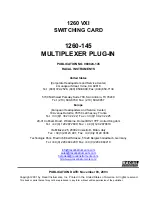
13
CO M
A
V
mA
uA
A
mA
uA
O FF
E
F
V
O
L
T
A
UT
O
SC
AN
COM
A
V
mA
uA
A
mA
uA
OFF
E
F
V
O
LT
A
UT
O
S
CA
N
3.2.4.
Continuity Check
To avoid electrical Shock and/or damage to the instrument, disconnect circuit Power and
discharge all high-voltage capacitors before testing for Continuity.
Continuity is a complete path for current flow. The beeper sounds if
a circuit is complete. These brief contacts cause the Meter to emit
a short beep.
To test continuity (set up the Meter as shown in Figure 3-4):
1)
Set the rotary switch to
Ω
range.
2)
Select auto scan mode or press the SELECT key to activate Continuity
Check.
3)
Connect the black and red test leads to the COM and
Ω
terminals
respectively.
4)
Connect the test leads to the resistance in the circuit being measured.
5)
When the test lead to the circuit is below 30
Ω
, a continuous beeping will
indicate it.
Figure 3-4
Checking the Continuity
3.2.5.
Diode Test
To avoid electrical shock and/or damage to the instrument, disconnect circuit Power and
discharge all high-voltage capacitors before testing diodes.
Use the diode test to check diodes, transistors, and other semiconductor
devices. The diode test sends a current through the semiconductor
junction, then measures the voltage drop across the junction, a good
silicon junction drops between 0.5V and 0.8V.
To test a diode out of a circuit (set up the Meter as shown in Figure 3-5):
1)
Set the rotary switch to
Ω
mode.
2)
Select the auto scan mode or press the SELECT key to activate Diode
Test.
3)
Connect the black and red test leads to the COM and V
Ω
terminals
respectively.
4)
For forward-bias readings on any semiconductor component, place the
red test lead on the component’s anode and place the black test lead on
the component’s cathode.
5)
The meter will show the approx. forward voltage of the diode.
Figure 3-5 Testing a Diode
Summary of Contents for AX-174
Page 1: ...AX 174 INSTRUCTION...




































